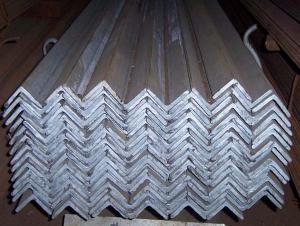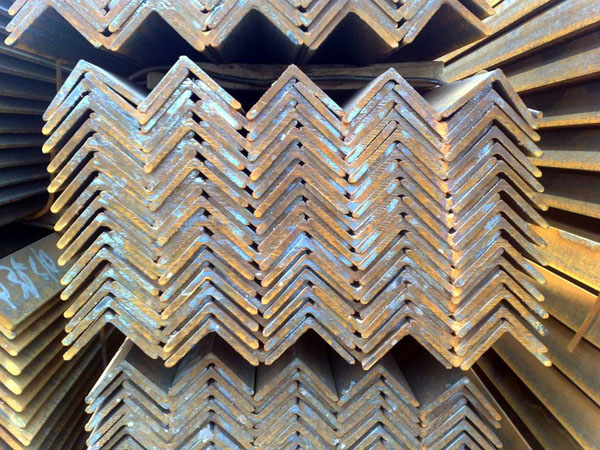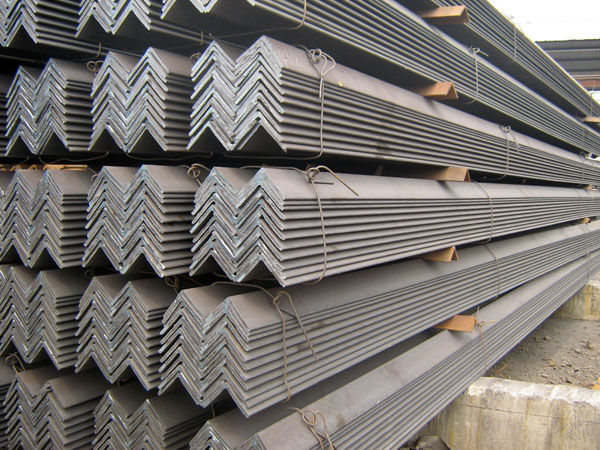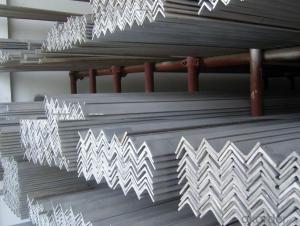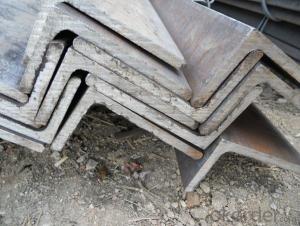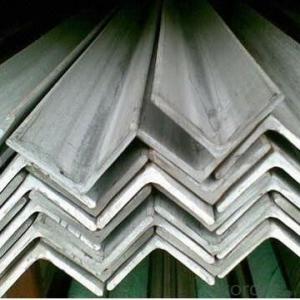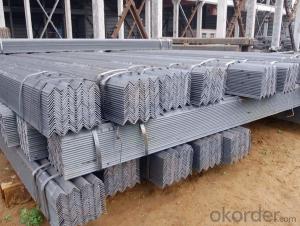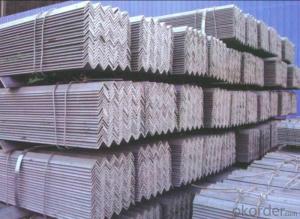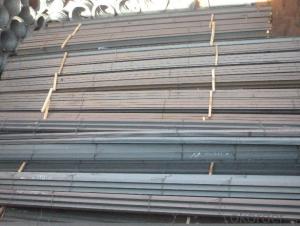equal angle
- Loading Port:
- China Main Port
- Payment Terms:
- TT OR LC
- Min Order Qty:
- -
- Supply Capability:
- -
OKorder Service Pledge
OKorder Financial Service
You Might Also Like
Product Description:
Specifications of Equal Angle
1. Standards: GB,ASTM,BS,AISI,DIN,JIS
2. Length:6m,9m,12m
3. Material:Material: GB Q235B, Q345B or Equivalent; ASTM A36; EN 10025, S235JR, S355JR; JIS G3192, SS400;
SS540.
4. Sizes:
Sizes: 25mm-250mm | ||
a*t | ||
25*2.5-4.0 | 70*6.0-9.0 | 130*9.0-15 |
30*2.5-6.6 | 75*6.0-9.0 | 140*10-14 |
36*3.0-5.0 | 80*5.0-10 | 150*10-20 |
38*2.3-6.0 | 90*7.0-10 | 160*10-16 |
40*3.0-5.0 | 100*6.0-12 | 175*12-15 |
45*4.0-6.0 | 110*8.0-10 | 180*12-18 |
50*4.0-6.0 | 120*6.0-15 | 200*14-25 |
60*4.0-8.0 | 125*8.0-14 | 250*25 |
5. Chemical data: %
C | Mn | S | P | Si |
0.14-0.22 | 0.30-0.65 | ≤0.050 | ≤0.045 | ≤0.30 |
Usage & Applications of Equal Angle
Trusses;
Transmission towers;
Telecommunication towers;
Bracing for general structures;
Stiffeners in structural use.
Packaging & Delivery of Equal Angle
1. Transportation: the goods are delivered by truck from mill to loading port, the maximum quantity can be loaded is around 40MTs by each truck. If the order quantity cannot reach the full truck loaded, the transportation cost per ton will be little higher than full load.
2. With bundles and load in 20 feet/40 feet container, or by bulk cargo, also we could do as customer's request.
3. Marks:
Color mark: There will be color marking on both end of the bundle for the cargo delivered by bulk vessel. That makes it easily to distinguish at the destination port.
Tag mark: There will be tag mark tied up on the bundles. The information usually including supplier logo and name, product name, made in China, shipping marks and other information request by the customer.
If loading by container the marking is not needed, but we will prepare it as customer request.
- Q: How do you determine the required thickness of a steel angle for a specific load?
- To determine the required thickness of a steel angle for a specific load, various factors need to be considered. These include the magnitude and direction of the load, the length and support conditions of the angle, and the desired safety factor. By analyzing these factors, engineers can utilize structural analysis techniques and calculations to determine the appropriate thickness of the steel angle that can withstand the given load without experiencing failure or excessive deflection.
- Q: How do you calculate the buckling strength of a steel angle?
- The buckling strength of a steel angle can be calculated using Euler's formula for buckling. This formula takes into account the length and moment of inertia of the angle, as well as the axial load applied to it. By plugging in the appropriate values and solving the equation, we can determine the buckling strength of the steel angle.
- Q: What is the use of angle steel and channel steel?
- Used to make steel structures, such as steel staircases, plant supports, etc..
- Q: How do steel angles differ from other structural shapes?
- Steel angles differ from other structural shapes in that they have two legs that are perpendicular to each other, forming a 90-degree angle. This unique shape provides additional strength and stability, making steel angles ideal for applications that require structural support, such as construction, manufacturing, and engineering projects.
- Q: Are steel angles suitable for corrosive environments?
- Corrosive environments can be suitable for steel angles depending on the specific conditions and the type of steel utilized. Stainless steel angles, for instance, exhibit exceptional resistance against corrosion due to their composition rich in chromium and nickel. These angles find extensive application in environments that encounter moisture, chemicals, or saltwater, such as marine applications or industrial settings. On the other hand, carbon steel angles may not be as appropriate for corrosive environments as they tend to be more susceptible to rust and corrosion. In such instances, it may be necessary to employ additional protective measures like coatings or galvanization to enhance their resistance against corrosion. To determine the most suitable steel angles for corrosive environments, it is crucial to consider the specific corrosive elements present in the environment, the extent of exposure, and the desired longevity of the angles. Seeking guidance from a corrosion specialist or an engineer with expertise in materials selection can aid in making informed decisions.
- Q: Can steel angles be used in decorative or architectural applications?
- Yes, steel angles can be used in decorative or architectural applications. Steel angles are versatile and can be shaped and manipulated to create various architectural elements such as decorative trims, ornamental railings, window frames, door frames, and even structural features like support brackets. Additionally, steel angles can be coated or finished in different ways to enhance their aesthetic appeal, such as by painting, powder coating, or patina finishes. Their strength and durability make them suitable for both indoor and outdoor applications, providing structural integrity while also adding a visually appealing element to the design. Overall, steel angles offer a wide range of design possibilities and can be effectively used in decorative or architectural applications.
- Q: How do you calculate the moment resistance of a steel angle connection?
- To calculate the moment resistance of a steel angle connection, you need to consider factors such as the geometry of the connection, the material properties of the steel angle, and the applied loads. The moment resistance can be determined by analyzing the section properties of the angle, such as the moment of inertia and the distance from the centroid to the extreme fiber. Additionally, you need to consider the strength of the steel material, typically provided by the manufacturer. By combining these factors and using appropriate design equations or software, you can calculate the moment resistance of the steel angle connection.
- Q: What is the tensile strength of steel angles?
- The tensile strength of steel angles can vary depending on the specific grade and manufacturing process, but it is generally considered to be high.
- Q: Can steel angles be used for conveyor systems?
- Yes, steel angles can be used for conveyor systems. Steel angles are often used as structural supports in conveyor systems due to their strength and durability. They can be used to create frames, supports, and guides for the conveyor belts, ensuring stability and proper functioning of the system.
- Q: How are steel angles installed on concrete structures?
- Steel angles are commonly used in concrete structures to provide additional strength and support. The process of installing steel angles on concrete structures involves a few steps. First, the concrete surface needs to be prepared. This includes cleaning the surface thoroughly and removing any debris or loose material. The concrete should be in a sound condition, free from cracks or other structural issues. Next, the steel angles need to be positioned and marked on the concrete surface. This is typically done by using a measuring tape and a chalk line. The angles are usually placed at specific intervals and locations, based on the structural requirements. After marking the positions, the concrete surface needs to be drilled. This is done using a drill and a masonry bit that is appropriate for the size of the anchor bolts or fasteners that will be used. The holes should be drilled to the required depth, ensuring a secure and stable installation. Once the holes are drilled, anchor bolts or fasteners are inserted into the holes. These bolts or fasteners are specifically designed for securing steel angles to concrete surfaces. They are typically made of steel and have a threaded end that allows them to be tightened securely into the concrete. After inserting the anchor bolts or fasteners, the steel angles are positioned and aligned with the marked locations on the concrete surface. The angles are then secured to the concrete by tightening the nuts on the anchor bolts or fasteners. Finally, the installation is checked for accuracy and stability. The angles should be firmly attached to the concrete surface and should not move or shift when pressure is applied. Any adjustments or additional tightening may be necessary to ensure a secure and reliable installation. Overall, the process of installing steel angles on concrete structures involves careful preparation, drilling, anchoring, and securing. This ensures that the angles provide the necessary strength and support required for the specific application.
Send your message to us
equal angle
- Loading Port:
- China Main Port
- Payment Terms:
- TT OR LC
- Min Order Qty:
- -
- Supply Capability:
- -
OKorder Service Pledge
OKorder Financial Service
Similar products
Hot products
Hot Searches
Related keywords
